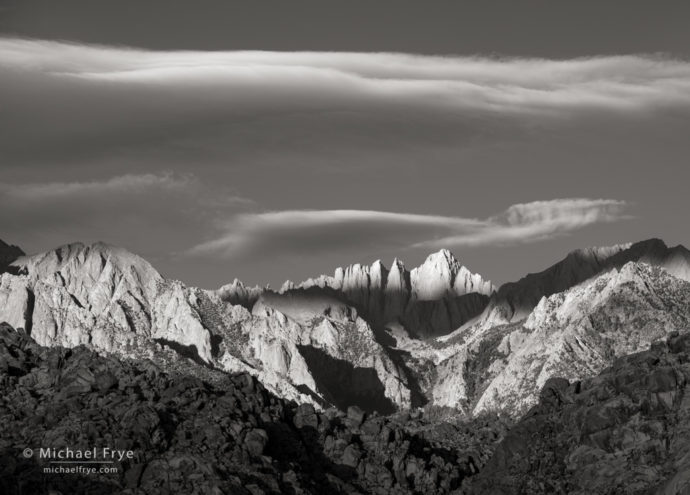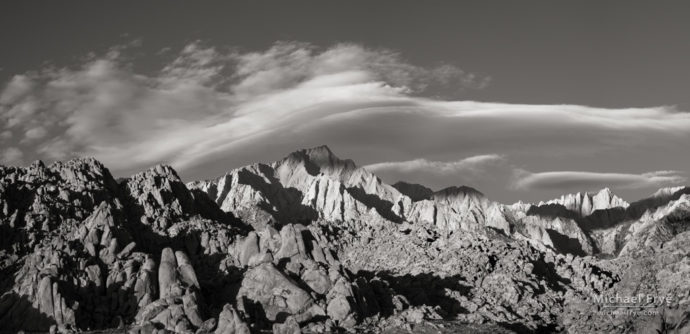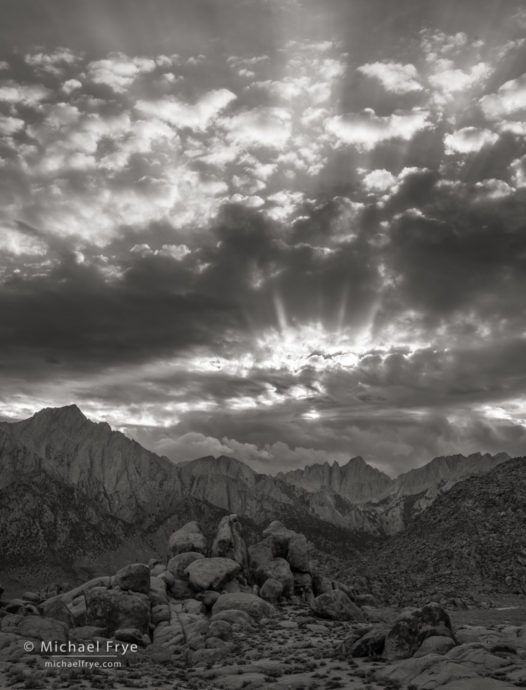On our trip to the eastern Sierra last week Claudia and I made a detour down to the Alabama Hills. This area is a bit further from home than our usual eastside haunts, so we don’t go there often, and I sometimes forget how amazing it is. The jumbled rocks of the Alabama Hills are interesting and photogenic in their own right, but combined with the abrupt escarpment of the mountains to the west… well it’s just spectacular.
I woke up early at our campsite Wednesday morning, just at first light, and noticed there were a lot of clouds drifting overhead. Time to get going! Most of the clouds were to the east. I found a view I liked in that direction, only to be disappointed when the clouds didn’t light up as I had hoped. But then a wave cloud suddenly formed over the mountains to the west. I quickly moved to a different spot, looking west toward a V-shaped notch in the boulders underneath Mt. Whitney. The mountain itself was shadowed at first, but then the sun broke through the cloud layers and lit the peak.
As always, I tried to adapt my compositions to the changing light. In the photograph above I liked the layers of light and dark above and below Mt. Whitney, so I zoomed in on that area to emphasize those layers (the focal length was 100mm). Layers – either bands of light and dark or layers of different colors – are a common compositional theme in landscape photography. These horizontal bands work because they create repetition, and they’re something I look for and try to recognize when they occur.
A few minutes later the sun reached the foreground rocks. The texture of the rocks to the left of Lone Pine Peak caught my eye, so I used a wider lens (50mm) to include some of those boulders, along with Lone Pine Peak, Mt. Whitney, and the clouds:
The clouds persisted all day. At times we could see that it was raining or snowing up on Mt. Whitney. As sunset approached there were a lot of clouds to the west – too many, actually, because they blocked the light. But at one point sunbeams broke through the clouds right above Mt. Whitney. The contrast was extreme, so for this photo I bracketed three frames, two stops apart, and used Lightroom’s HDR Merge to blend the exposures:
We had a great time in the Alabama Hills, and I’m sure we’ll go back again soon. I feel so fortunate to live in this state full of such wonderful, diverse landscapes.
— Michael Frye
Related Posts: North Lake Sunset; Early Autumn Color
Michael Frye is a professional photographer specializing in landscapes and nature. He is the author or principal photographer of The Photographer’s Guide to Yosemite, Yosemite Meditations, Yosemite Meditations for Women, Yosemite Meditations for Adventurers, and Digital Landscape Photography: In the Footsteps of Ansel Adams and the Great Masters. He has also written three eBooks: Light & Land: Landscapes in the Digital Darkroom, Exposure for Outdoor Photography, and Landscapes in Lightroom: The Essential Step-by-Step Guide. Michael has written numerous magazine articles on the art and technique of photography, and his images have been published in over thirty countries around the world. Michael has lived either in or near Yosemite National Park since 1983, currently residing just outside the park in Mariposa, California.












Very very nice, I enjoy following your work
Thanks Doug!
Diversity – from the heights of Mt Whitney to the low of Death Valley, from the ocean to depths of Lake Tahoe, from the tallest and largest Redwoods and Sequoias to the Bristlecone pines – oldest little gnarly trees, it is quite an AMAZING state indeed to live and explore!
Well said Alma! There are many, many wonderful, beautiful places in the world, but if I had to photograph in just one state for the rest of my life I’d pick California.
Hi Michael,
That first shot just really draws me in. What a wonderful scene and composition in B&W.
Thanks Doug!
Love your work.
Thanks Linda!
Love that area. Some of my favorite shots were taken there.
Understandable – it’s a great area.
How ironic. I’m just back from almost a month in and around Yosemite. I stayed in the Valley for 7 nights, then Tioga Pass Resort for 10 days and then back in the valley for a further 7 days. Full-on photography for over 3 weeks.
Your book and your writings on here were so helpful. Thank you. And I spoke to Julia the the AA Gallery about your work (I spent my first two days with her).
I was up Bishop’s Creek the week before you and was blown away by the Aspens up the South Lake fork. Scotland is beautiful, but I’ve never seen anything like that.
On my last day, I met a lady who had also lost her lifetime-partner. We spoke about my photography and my first love of making B & W images. Her first comment was, ‘Have you been to the Alabama Hills?’ Regretably my answer was ‘No’. From your post above, I now see why she said that.
Thank you for all your help (unknown as it was)in and around Yosemite from September 7th to 30th. It was the fulfillment of a dream.
Thanks for sharing your story Donald. I’m glad you found the book helpful, and it sounds like you had a good trip. Next time you’ll have to visit the Alabama Hills – but then there are so many places to go.
Great pics. I’ll never forget the first time i drove into this place. Unforgettable really. I’m so lucky I can be there in about 3 hours or so. Paradise for me, camera or no camera. Sometimes me and the girls we just sit there and talk to the ravens. I agree with doug, that first image hits me personally… the eerie hand like cloud.. the half shadow … there is a mystery to the moment that I think is conveyed in the snap. It captivates me. I’m always fascinated in the small things, haven’t quite figured then all out, but they sure do matter in an odd cosmic compelling way. I’m also intrigued by the levels of light and shadow through out the frame top to bottom… and it crops pretty awesome too.
http://www.lightballet.com/images/crop.jpg
ps Hope you don’t mind me makin a crop… I’m out of control with my cropping. I think it’s one of my favorite things to do.. sit and watch TV cropping other people images. I learn a lot about myself through croppings.